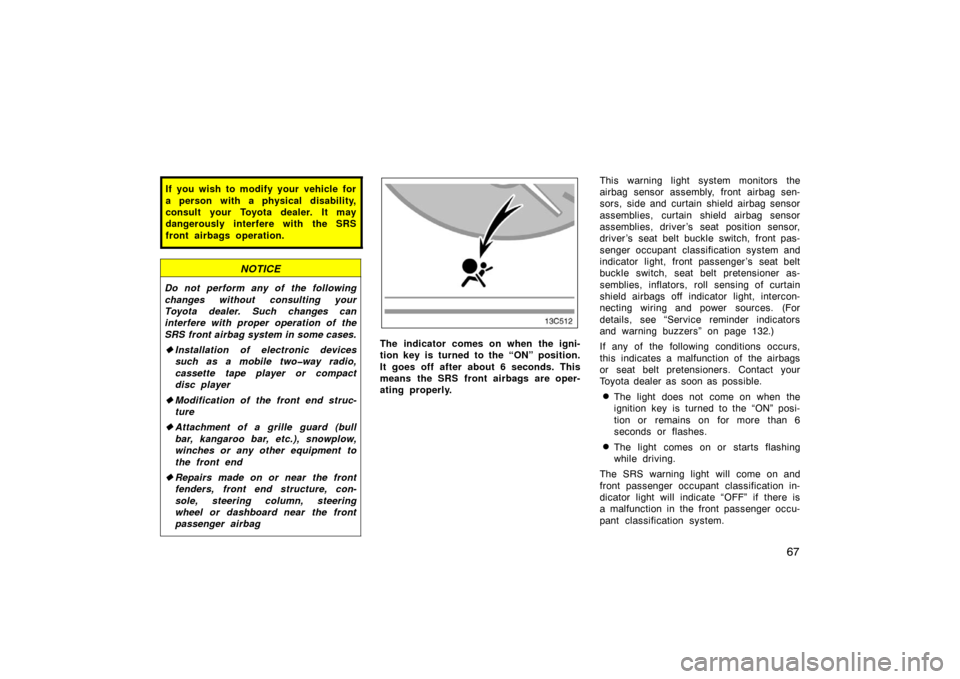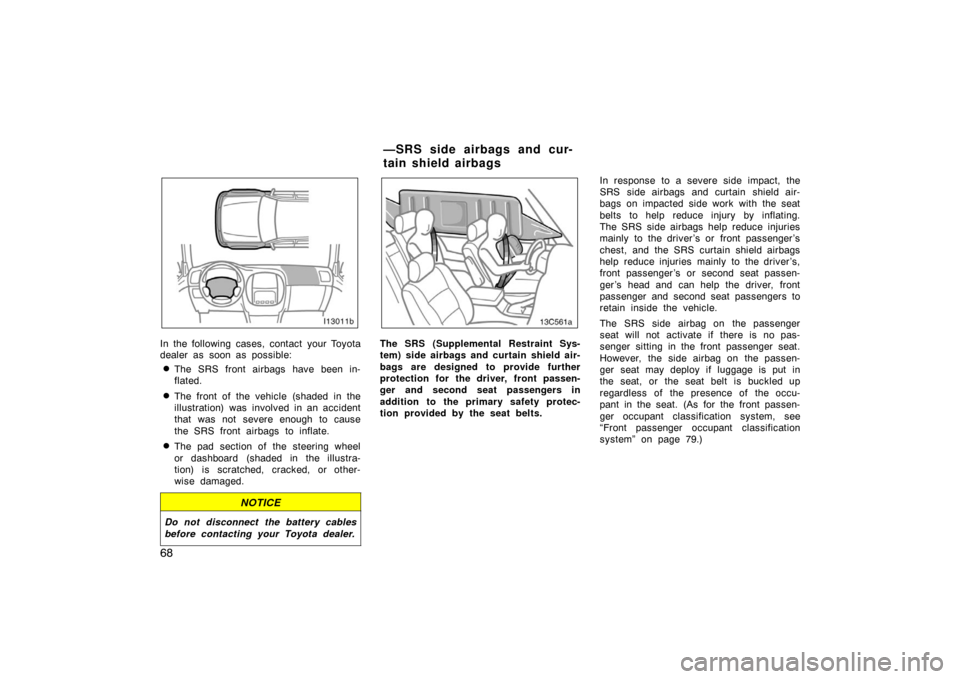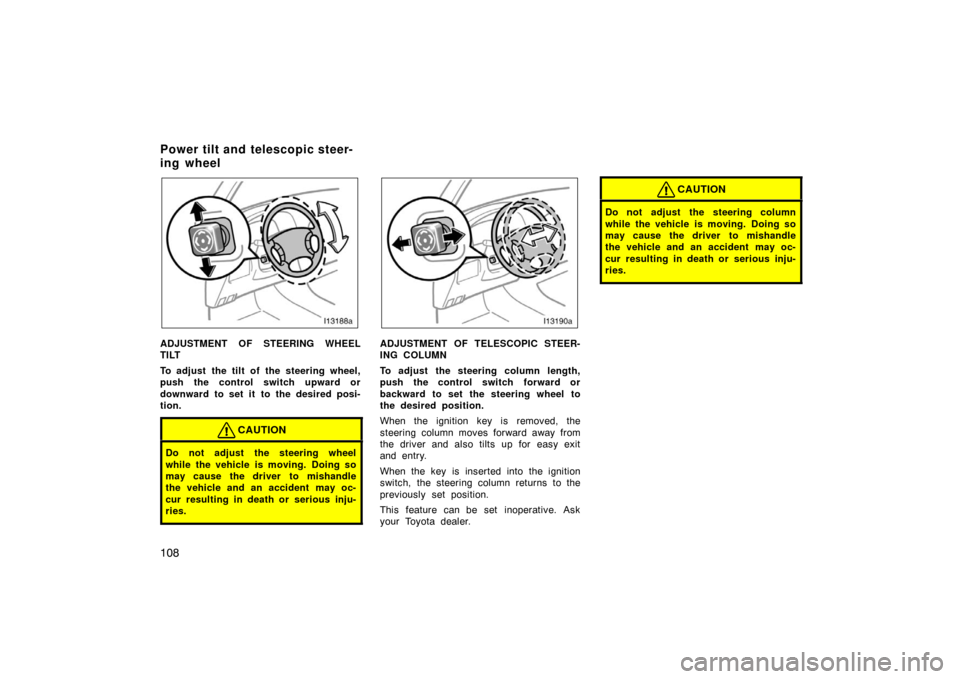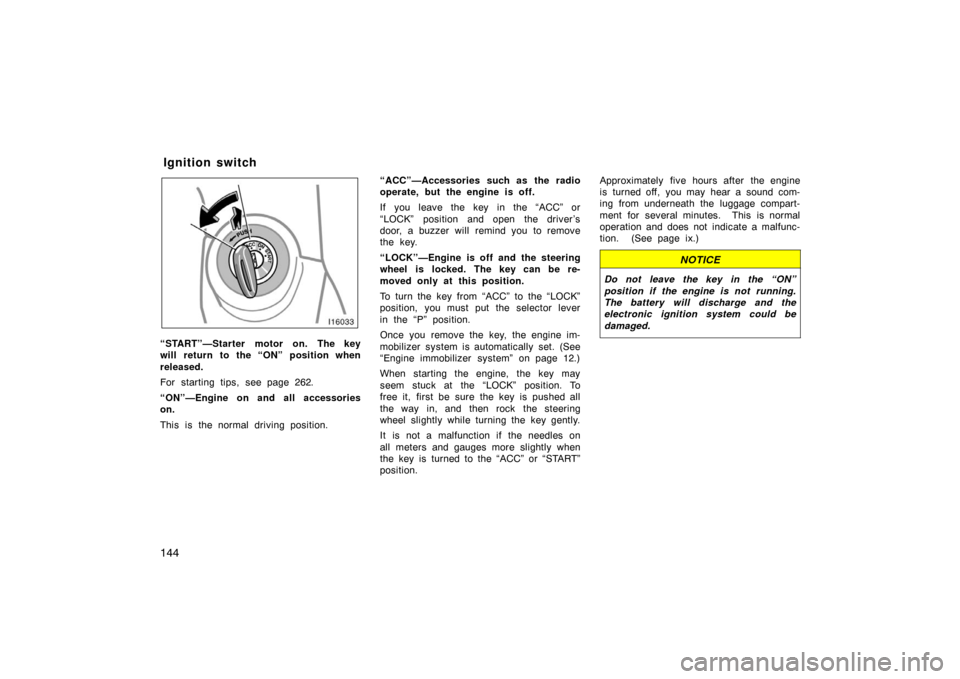Page 81 of 374

67
If you wish to modify your vehicle for
a person with a physical disability,
consult your Toyota dealer. It may
dangerously interfere with the SRS
front airbags operation.
NOTICE
Do not perform any of the following
changes without consulting your
Toyota dealer. Such changes can
interfere with proper operation of the
SRS front airbag system in some cases.
�Installation of electronic devices
such as a mobile two�way radio,
cassette tape player or compact
disc player
� Modification of the front end struc-
ture
� Attachment of a grille guard (bull
bar, kangaroo bar, etc.), snowplow,
winches or any other equipment to
the front end
� Repairs made on or near the front
fenders, front end structure, con-
sole, steering column, steering
wheel or dashboard near the front
passenger airbag
The indicator comes on when the igni-
tion key is turned to the “ON” position.
It goes off after about 6 seconds. This
means the SRS front airbags are oper-
ating properly. This warning light system monitors the
airbag sensor assembly, front airbag sen-
sors, side and curtain shield airbag sensor
assemblies, curtain shield airbag sensor
assemblies, driver ’s seat position sensor,
driver’s seat belt buckle switch, front pas-
senger occupant classification system and
indicator light, front passenger ’s seat belt
buckle switch, seat belt pretensioner as-
semblies, inflators, roll sensing of curtain
shield airbags off indicator light, intercon-
necting wiring and power sources. (For
details, see “Service reminder indicators
and warning buzzers” on page 132.)
If any of the following conditions occurs,
this indicates a malfunction of the airbags
or seat belt pretensioners. Contact your
Toyota dealer as soon as possible.
�The light does not come on when the
ignition key is turned to the “ON” posi-
tion or remains on for more than 6
seconds or flashes.
�The light comes on or starts flashing
while driving.
The SRS warning light will come on and
front passenger occupant classification in-
dicator light will indicate “OFF” if there is
a malfunction in the front passenger occu-
pant classification system.
Page 82 of 374

68
In the following cases, contact your Toyota
dealer as soon as possible:
�The SRS front airbags have been in-
flated.
�The front of the vehicle (shaded in the
illustration) was involved in an accident
that was not severe enough to cause
the SRS front airbags to inflate.
�The pad section of the steering wheel
or dashboard (shaded in the illustra-
tion) is scratched, cracked, or other-
wise damaged.
NOTICE
Do not disconnect the battery cables
before contacting your Toyota dealer.
13c561a
The SRS (Supplemental Restraint Sys-
tem) side airbags and curtain shield air-
bags are designed to provide further
protection for the driver, front passen-
ger and second seat passengers in
addition to the primary safety protec-
tion provided by the seat belts. In response to a severe side impact, the
SRS side airbags and curtain shield air-
bags on impacted side work with the seat
belts to help reduce injury by inflating.
The SRS side airbags help reduce injuries
mainly to the driver’s or front passenger’s
chest, and the SRS curtain shield airbags
help reduce injuries mainly to the driver ’s,
front passenger ’s or second seat passen-
ger’s head and can help the driver, front
passenger and second seat passengers to
retain inside the vehicle.
The SRS side airbag on the passenger
seat will not activate if there is no pas-
senger sitting in the front passenger seat.
However, the side airbag on the passen-
ger seat may deploy if luggage is put in
the seat, or the seat belt is buckled up
regardless of the presence of the occu-
pant in the seat. (As for the front passen-
ger occupant classification system, see
“Front passenger occupant classification
system” on page 79.)
—SRS side airbags and cur-
tain shield airbags
Page 121 of 374
107
OPERATION OF INSTRUMENTS AND
CONTROLS
Steering wheel and Mirrors
Power tilt and telescopic steering wheel108
. . . . . . . . . . . . . . . . . . . . . . .
Outside rear view mirrors 109
. . . . . . . . . . . . . . . . . . . . . . . . . . . . . . . . . . . . \
Anti −glare inside rear view mirror 11 0
. . . . . . . . . . . . . . . . . . . . . . . . . . . . .
Sun visors 11 5
. . . . . . . . . . . . . . . . . . . . . . . . . . . . . . . . . . . . \
. . . . . . . . . . . . .
SECTION 1� 4
Page 122 of 374

108
ADJUSTMENT OF STEERING WHEEL
TILT
To adjust the tilt of the steering wheel,
push the control switch upward or
downward to set it to the desired posi-
tion.
CAUTION
Do not adjust the steering wheel
while the vehicle is moving. Doing so
may cause the driver to mishandle
the vehicle and an accident may oc-
cur resulting in death or serious inju-
ries.
ADJUSTMENT OF TELESCOPIC STEER-
ING COLUMN
To adjust the steering column length,
push the control switch forward or
backward to set the steering wheel to
the desired position.
When the ignition key is removed, the
steering column moves forward away from
the driver and also tilts up for easy exit
and entry.
When the key is inserted into the ignition
switch, the steering column returns to the
previously set position.
This feature can be set inoperative. Ask
your Toyota dealer.
CAUTION
Do not adjust the steering column
while the vehicle is moving. Doing so
may cause the driver to mishandle
the vehicle and an accident may oc-
cur resulting in death or serious inju-
ries.
Power tilt and telescopic steer-
ing wheel
Page 158 of 374

144
“START”—Starter motor on. The key
will return to the “ON” position when
released.
For starting tips, see page 262.
“ON”—Engine on and all accessories
on.
This is the normal driving position.“ACC”—Accessories such as the radio
operate, but the engine is off.
If you leave the key in the “ACC” or
“LOCK” position and open the driver’s
door, a buzzer will remind you to remove
the key.
“LOCK”—Engine is off and the steering
wheel is locked. The key can be re-
moved only at this position.
To turn the key from “ACC” to the “LOCK”
position, you must put the selector lever
in the “P” position.
Once you remove the key, the engine im-
mobilizer system is automatically set. (See
“Engine immobilizer system” on page 12.)
When starting the engine, the key may
seem stuck at the “LOCK” position. To
free it, first be sure the key is pushed all
the way in, and then rock the steering
wheel slightly while turning the key gently.
It is not a malfunction if the needles on
all meters and gauges more slightly when
the key is turned to the “ACC” or “START”
position.Approximately five hours after the engine
is turned off, you may hear a sound com-
ing from underneath the luggage compart-
ment for several minutes. This is normal
operation and does not indicate a malfunc-
tion. (See page ix.)
NOTICE
Do not leave the key in the “ON”
position if the engine is not running.
The battery will discharge and the
electronic ignition system could be
damaged.
Ignition switch
Page 168 of 374

154
The vehicle stability control system
helps provide integrated control of the
systems such as anti�lock brake, trac-
tion control, engine control, etc. This
system automatically controls the out-
put of the brakes or engine to help
prevent the vehicle from skidding under
adverse conditions.
The vehicle stability control system is acti-
vated when the vehicle speed is about
more than 15 km/h (9 mph).
You may hear a sound in the engine
compartment for a few seconds when the
engine is started or just after the vehicle
begins to move. This means that the ve-
hicle stability control system is in the
self−check mode and does not indicate a
malfunction.CAUTION
�Active traction control system, ve-
hicle stability control system and
anti�lock brake system are electron-
ic systems designed to help the
driver maintain control under ad-
verse conditions. They are not a
substitute for safe driving practices.
Factors including speed, road con-
ditions and driver steering input
can all affect whether active trac-
tion control system, vehicle stability
control system and anti�lock brake
system will be effective in prevent-
ing a loss of control. Always keep
safety driving in mind. If the slip
indicator light flashes, sounding an
alarm, special care should be taken
while driving.
�Only use tires of specified size. The
size, manufacturer, brand and tread
pattern for all 4 tires should be the
same. If you use the tires other
than specified, or different type or
size, the vehicle stability control
system may not function correctly.
When replacing the tires or wheels,
contact your Toyota dealer. (See
“Checking and replacing tires” on
page 333.)
Vehicle stability control
system
Page 183 of 374

169
(b) Automatic leveling function
Regardless of the number of occupants
or the luggage loading condition, the
vehicle height is always automatically
adjusted to a fixed height in any mode.
However, the vehicle height cannot be
raised if the vehicle load exceeds the lim-
its. (See “(d) Vehicle height adjustment”
described below.)(c) Vehicle height mode changing
condition
To change the vehicle height, it is nec-
essary to meet the following 3 condi-
tions.
�The engine should be running.
�All the side doors and back door
should be closed.
�The height control “OFF” indicator
light should go off.
When selecting a mode with the four −
wheel drive control lever at “H”, there is
a vehicle speed limit. Refer to the follow-
ing table.
Yes = The mode can be selected.
No = The mode cannot be selected.
Low
modeNormal
mode
High
mode
At vehicle
stoppageYe sYe sYe s
Under about 30
km/h (19 mph)NoYe sYe s
About 30 km/h
(19 mph) or overNoYe sNo
In the following cases the active height
control suspension does not operate
even if the above conditions are all
met.
�The brake pedal has been depressed
for longer than about 5 seconds with
the vehicle stopped.
�The suspension fluid temperature is
lower than –30 �C (–22 �F). If the en-
gine is warmed up, the suspension
fluid temperature will be raised as the
inside of the engine compartment be-
comes warmer. Then the active height
control system becomes operable.
�Driving on the bumpy roads, which
may cause the suspension to fully
elongate.
�The steering wheel is operated abruptly
more than 3/4 turns with center differ-
ential lock system activated.
Page 191 of 374
177
OPERATION OF INSTRUMENTS AND
CONTROLS
Audio system
Reference178
. . . . . . . . . . . . . . . . . . . . . . . . . . . . . . . . . . . . .\
. . . . . . . . . . . .
Using your audio system 178
. . . . . . . . . . . . . . . . . . . . . . . . . . . . . . . . . . . . \
Audio system operating hints 191
. . . . . . . . . . . . . . . . . . . . . . . . . . . . . . . .
Rear seat audio system 196
. . . . . . . . . . . . . . . . . . . . . . . . . . . . . . . . . . . . \
.
Audio remote controls (steering switches) 197
. . . . . . . . . . . . . . . . . . . . .
For vehicle equipped with Navigation system, please refer to the
separate “Navigation System Owner’s Manual”.
SECTION 1� 8